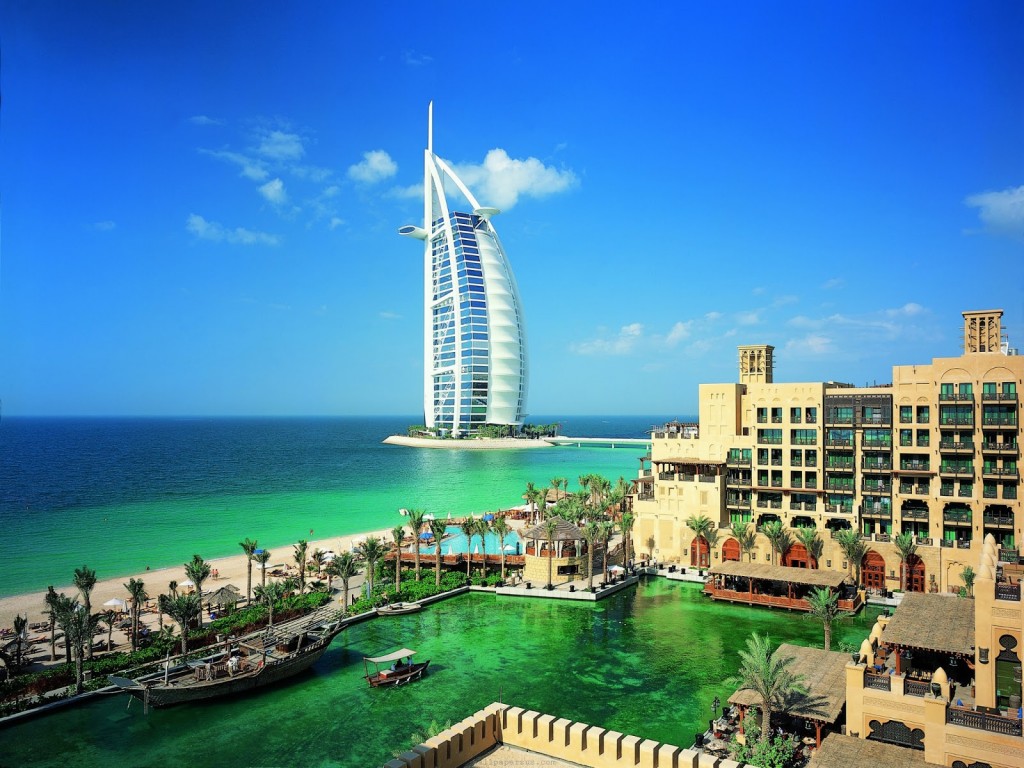Classified as one of the richest nations in the world, due to its vast oil reserves, Dubai is the byword for opulence and prosperity. This haven for vacationing tourists boasts life’s finest luxuries: pristine pearly-white sand beaches, blue waters and majestic palm trees, seen-from-space artificial islands, dazzling gold stores and world-class shopping malls, towering hotels and buildings in mega-proportions, and massive marine development complexes. Weaving through these urban edifices are the distinct Arabian allure of ornate Middle Eastern art and décor, the vast and eternally-reinventing sand dunes, dozing dromedaries, and the traditional Arabian way of life.
Getting around Dubai
If you would prefer to enjoy the sights around you rather than having to keep your eye on the road, there are several easy public transport options. The Dubai Metro covers the length of the city and stops at most major attractions along the way.
Dubai’s bus network is growing all the time and covers most parts of the city. While a bus ride may not always take you somewhere via the most direct route, it is a cheap and safe way to get around.
The Dubai Taxi Corporation, regulated by the Roads and Transport Authority, has a fleet of over 4,000 taxis. Flagging down a taxi is easy: apart from numerous taxi ranks around the city, and designated taxi areas at all shopping malls, you can raise your hand while walking along the city’s quieter roads (just not on major highways), and if the taxi is available, the driver will stop at the nearest safe spot.
If you are in the area of the Dubai Creek and wish to cross from one side to the other, taking an abra (traditional water taxi) is highly recommended. This is also a good area of the city to explore on foot, with numerous alleys and interesting souks to discover.
Best Time to Visit

Gad around Dubai any time between the months of October and April. Sporting and cultural events take place during the winter and spring seasons. Sports enthusiasts can catch world-class tournaments and competitions in rugby, horse race, golf, and tennis throughout this period. Dubai’s winter months usher in blue skies with temperatures perfect for beach-combing and basking luxuriously along the shores. Remember that these are the peak-season months, so check out this travel guide
Dubai’s climate is mostly hot the whole year. Summer temperature fluctuates from sweltering to scorching, and stretches from May to August. The last two months of summer are so unbearable that most people stay indoors or go on a trip to cooler places. The Ramadan spans these two months, too, when the city hibernates. Streets are quiet and most commercial establishments take a low-down. September and October bring the temperature to tolerable, but still uncomfortable, levels. November brings a welcome shift in terms of temperature and commerce sidles up with it, taking an upbeat tempo for the rest of the year. Tourism picks up and people move toward the beaches and over sand dunes. Cooler temperature wafts all through January and continues in this fashion to the ensuing months of spring.
Things to Do
There are many things that you can do in sun-drenched Dubai. Riding camels would be fun, but after having that postcard picture with these dromedaries, romp away and discover the nooks and crannies of Dubai.
1) Gaze at Dubai’s Skyline for Some of the World’s Tallest Structures
Start Dubai exploration by scanning the horizon. Gaze at the six or seven lofty structures that dominate the Dubai skyline. The tallest is Burj Khalifa, and incidentally is also the world’s tallest building. This skyscraper has become Dubai’s beacon that tells the world to come to the city and see what else Dubai has. It is worth-noting that Dubai has 5 of the world’s tallest hotels including the tallest which is JW Marriot Marquis Dubai standing at 355 meters with 77 floors.
2) Enjoy the Beach Strips
You shouldn’t leave Dubai without spending at least half a day along the shoreline. There are public beaches, as well as privately-developed beach areas. Jumeirah Beach Park has a quaint shop where you can laze around with a cup of coffee. There is a minimal entrance fee of USD 1.50. There are free alternatives, too, like the public Al Mamzar Beach in Al Hamriya and the Kite Beach in Umm Suqeim. Posh hotels, like the Le Meridien Mina Seyahi allows non-guests to bask in their luxurious beach facilities for a fee of USD 70.
3) Buy Gold
Do not miss the opportunity to buy affordable gold and other precious jewelry like silver, platinum, and diamonds. Buy from government-regulated outlets, like Gold Souk and the Gold & Diamond Park. Gold bought from reputed stores are certified cheap and genuine. You’ve gone as far as Dubai to buy gold, so don’t risk buying fake from merchants on the streets. Gold Souk main is along Khalid Bin Waleed Road, while the Gold & Diamond Park is along Sheikh Zayed Road.
4) Explore Traditional Dubai
While the whole of Dubai has been extensively re-engineered and redesigned, there remain traditional Dubai communities. Try this neighborhood called the Bastakiya Quarter, located between the Dubai Creek and Bur Dubai. This used to be a quiet fishing village, and it retains that village air about it.
5) Set Foot on Man-Made Islands
The tall buildings of Dubai are the megaprojects that the world often associates with the sheikdom. Less known but much more daring, though, is the reclamation of vast earth materials to build an artificial islands offshore Dubai. These are the three islands: the palm-tree shaped island of Palm Jumeirah, being claimed as the 8th world wonder; the second island is Palm Jebel Ali, which will feature a breakwater that will write a line of poetry; and Palm Deira, which will feature the miniature islands of the world. In case you’d be interested in owning a particular “country.” the islands are for sale.
